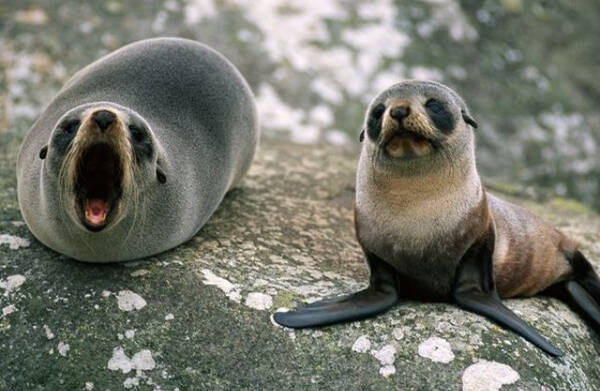Arctocephalus gazella
IUCN
LCBasic Information
Scientific classification
- name:Arctocephalus gazella
- Scientific Name:Arctocephalus gazella,Kerguelen Fur seal,Island sea lions, sea wolves, Antarctic fur seals
- Outline:Carnivora
- Family:S.L.family
Vital signs
- length:1.4-2m
- Weight:22-230kg
- lifetime:13-23years
Feature
Has the longest beard and bad breath
Distribution and Habitat
It is mainly distributed in Antarctic waters, south of the Antarctic Convergence Zone and on islands north of 65°S, namely South Shetland Islands, South Orkney Islands, South Sandwich Islands, South Georgia Island, Kerguelen, Blewitt, Heard and McDonald Islands.
Appearance
The body is covered with coarse hair and dense and thick hair. The average length of the coarse hair on the neck is 21.8mm, and the length on the abdomen is 12.7mm. The back is dark gray-brown, and the belly is slightly lighter. The skull is convex. The snout is wide and short. The base of the skull is 244mm long. The nose is short and 35mm, and the front part is wide and trumpet-shaped. The palate is wide and flat. There is a vacant space between the 4th to 5th and 5th to 6th cheek teeth in the upper jaw. The teeth are very small and single-pointed. From the front to the back, the crown of the teeth gradually decreases. Individual size: The male body length can reach 2m, and the weight is 110-230kg. The female body length is 1.4m, and the weight is 22-51kg. The body length of the young animal is 63-67cm, and the weight is 6-7kg.
Details
The Antarctic fur seal (scientific name: Arctocephalus gazella) is called Kerguelen Fur seal. Its scientific name comes from the first German ship to capture it, SMS Gazelle. Captain Cook mentioned that there were a large number of fur seals living on South Georgia Island after exploring it in 1775.

Antarctic fur seals feed almost exclusively on krill in South Georgia, and also eat Antarctic fish, squid and penguins. The Antarctic fur seal has a diving record of 1,000 feet, and one in 1,000 Antarctic fur seals is a golden albino. Antarctic fur seals only eat krill, but their bad breath is 10,000 times worse than the stinkiest dog's bad breath. A bite from their mouths full of bacteria will cause bacterial infection.
Antarctic fur seals are distributed in scattered archipelagos and small islands near Antarctica. Every spring during the breeding season, 100,000 Antarctic fur seals gather on South Georgia Island. Antarctic fur seals can turn their flippers and run on the road. Male Antarctic fur seals will fiercely protect their wives and concubines. Female fur seals that mate with male fur seals will give birth in the breeding season of the following year. Seven days after the baby fur seals are born, the female fur seals will mate again, and the baby fur seals must be self-reliant at this time. The lactation period is about 4 months. Females reach sexual maturity in 3 to 4 years and males in 8 years. It is known that females can live for 23 years. Males 13 years.

Pinnipeds (i.e. seals, sea lions and walruses) have the longest whiskers or barbels of all mammals. No animal can surpass the Antarctic fur seal in this regard. Male fur seals' whiskers are generally 35 cm long, while female fur seals have whiskers ranging from 13 to 22 cm. The 1968 British Antarctic Expedition Scientific Report describes a unique bull from South Georgia with a beard that reaches 48 cm in length. If its amazing beard is fully extended, it can be as long as 106.5 cm. (Guinness World Records)
Listed in Appendix I, II and III of the Convention on International Trade in Endangered Species of Wild Fauna and Flora (CITES) 2019 Edition Appendix II.
Protect wildlife and eliminate game.
Maintaining ecological balance is everyone's responsibility!








